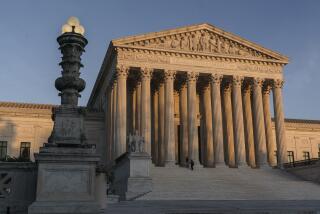Choices May Reflect Desire to Extend Legacy Into Next Century : Reagan Naming Young Appellate Judges
WASHINGTON â President Reagan, the nationâs oldest chief executive, has appointed the youngest set of federal appeals court judges in American history during his second term.
According to data published by the American Bar Assn., more than one-third of Reaganâs appeals court nominees since 1985 have been under 45, a percentage far higher than that of any of his predecessors.
This is a departure for Republican presidents, who have been known for appointing to the federal courts lawyers and lower court judges with broad experience who were in their 50s and 60s. By contrast, Atty. Gen. Edwin Meese III has sought out nominees for President Reagan who are bright, young and conservative. âI think this reflects their desire to carry on the Reagan legacy long after he leaves office. These people will be on the bench well into the next century,â said Sheldon Goldman, a political science professor at the University of Massachusetts at Amherst, who compiled the statistics.
13 Judges Under 45
Since Meese took over at the Justice Department in 1985, 13 of the 38 Reagan appointees to the appeals courts have been under 45. It was one of those young judges--41-year old Douglas H. Ginsburg--who was nominated Thursday to the Supreme Court.
Ginsburg, who was named by Reagan to the appeals court here last year, is the second youngest Supreme Court nominee in this century.
But he was not the youngest person on the Justice Departmentâs list of possible nominees. Edith H. Jones of Houston, a Reagan appointee to the U.S. 5th Circuit Court of Appeals in 1985, was considered, too, even though she is only 38 years old. Also on the list at one point was Frank Easterbrook of Chicago, who was 35 when named to the 7th Circuit appeals court in 1985.
Terry Eastland, a spokesman for Meese, said that the Administration has âsought out young but extremely well qualified lawyers who are committed to judicial restraint.â Because relatively few lawyers and law professors adhere to the Administrationâs brand of âjudicial restraint,â the pool of potential nominees is not large, Eastland said.
Never in Private Practice
Besides being young and conservative, Ginsburg fits the mold of other Reagan judicial nominees in that his background is in academia and government service. Ginsburg taught for six years at the Harvard University Law School and served three years in the Reagan Administration. He has not practiced law privately.
Since becoming attorney general in 1985, Meese has focused on the federal appeals courts when recommending nominees to the high court. So far, all three nominees during the second Reagan term--Antonin Scalia, Robert H. Bork and Ginsburg--have come from the appeals court for the District of Columbia, often called the nationâs second most important court because of the number of government cases decided there.
In the 20th Century, three of the 50 justices who have served on the Supreme Court were under age 45 when nominated.
Byron R. White, a Rhodes scholar, former football star and deputy attorney general, was 44 when appointed by President John F. Kennedy in 1962. He still sits on the high court.
Potter Stewart was a 43-year-old judge on the U.S. 6th Circuit Court of Appeals when President Dwight D. Eisenhower chose him in 1958. Stewart had been a member of the Cincinnati City Council and was the cityâs vice mayor before serving four years on the appeals court. On the Supreme Court, he served 22 years and stepped down in 1981.
Douglas Served 36 Years
William O. Douglas was only 40 when chosen by President Franklin D. Roosevelt in 1939. Douglas was a business lawyer, a Yale University law professor and chairman of the Securities and Exchange Commission before his appointment. He served for 36 years, the longest tenure of any high court justice.
The Justice Departmentâs East-land said that Ginsburgâs career to this point âsounds pretty parallelâ to that of Douglas. Both were grad-uated second in their classes from prestigious law schools, taught law for several years and served in several governmental positions in Washington.
Douglas, unlike Ginsburg, was a well-known figure in government during Rooseveltâs New Deal. But, unlike Douglas, âGinsburg has had a year on a federal court,â Eastland said.
Average Ages of Nominees
Among earlier presidents, the average age for appeals court nominees ranged from a high of 59.5 under Warren G. Harding from 1921 to 1923 to a low of 50.7 in Theodore Rooseveltâs Administration from 1901 to 1909. Reaganâs nominees in the second term had an average age of 48.7, according to data through July of this year.
During Reaganâs first term, the nominees had an average age of 51.5, virtually the same as the 51.9 average age of appointees by President Jimmy Carter.
Under Carter, 10 of 56 appeals court nominees--or 18%--were under 45. But that percentage has been nearly doubled in Reaganâs second term.
Since World War II, presidents named these percentages of appellate nominees under 45: Harry S. Truman, 11%; Eisenhower, 9%; Kennedy, 9%; Lyndon B. Johnson, 12%; Richard M. Nixon, 7%; Gerald R. Ford, 8%; Carter, 18%; Reaganâs first term, 16%, and Reaganâs second term, 34%
Next to Reagan, the youthful Theodore Roosevelt appointed the youngest judges. About 22% of his judicial nominees were under 45.
More to Read
Get the L.A. Times Politics newsletter
Deeply reported insights into legislation, politics and policy from Sacramento, Washington and beyond. In your inbox three times per week.
You may occasionally receive promotional content from the Los Angeles Times.











